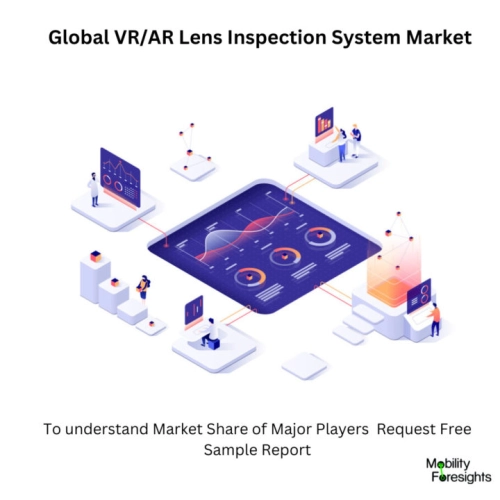
- Get in Touch with Us

Last Updated: Apr 25, 2025 | Study Period: 2023-2030
GLOBAL VR/AR LENS INSPECTION SYSTEM MARKET
INTRODUCTION
For the purpose of display testing in AR, VR, and MR headsets and glasses, the AR/VR Lens inspection system duplicates the size, position, and field of view of the human eye.
Beyond their potential usage in video games and entertainment, AR and VR have a wide range of possible applications. For real-time instructions, safer surgical training, marketing and advertising on mobile apps, more engaging educational opportunities, and a variety of other uses, AR/VR could be employed by assembly workers.
Although the technology is still in its infancy, AR/VR may have a significant impact on a number of different businesses.For AR/VR applications, 3D objects may be detected and virtual surface reconstruction can be done more precisely.
The effectiveness of the display inspection system in AR/VR applications plays a critical role in how closely the device can replicate reality and accurately recreate virtual environments.
New lenses with apertures at the front of the vision system enable display inspections at the same distance as the human eye would examine the display in AR/VR systems. The inspection procedure has been improved, allowing for the creation of higher-quality AR/VR displays.
GLOBAL VR/AR LENS INSPECTION SYSTEM MARKET SIZE AND FORECAST

Global VR/AR Lens Inspection System market accounted for $XX Billion in 2022 and is anticipated to reach $XX Billion by 2030, registering a CAGR of XX% from 2023 to 2030.
NEW PRODUCT LAUNCH
The AR/VR lens inspection system from Radiant Vision Systems features a particular optical design made for measuring near-eye displays (NEDs), such as those found in virtual reality (VR), mixed reality (MR), and augmented reality (AR) headsets.
The lens's configuration mimics the dimensions, orientation, and field of vision of the human eye. The AR/VR lens' aperture is on the front of the lens, as opposed to other lens options where the aperture is inside the lens. This allows positioning of the imaging system's entrance pupil within NED headsets at the same location as the human eye.
The Radiant Vision Systems AR/VR lens features aperture characteristics that simulate the approximate size, position, and field of vision of the human eye and was specifically created for display quality evaluation in NED headsets.
The connected imaging system can capture the whole field of view (FOV) of the display (up to 120° horizontal, roughly approximating human binocular FOV) without being constrained by the lens hardware thanks to the aperture at the front of the lens.
Displays may be measured under the same circumstances as they are seen by a human observer because the aperture size of 3.6 mm also corresponds to the size of a human entry pupil.
COMPANY PROFILE
THIS REPORT WILL ANSWER FOLLOWING QUESTIONS
| Sl no | Topic |
| 1 | Market Segmentation |
| 2 | Scope of the report |
| 3 | Abbreviations |
| 4 | Research Methodology |
| 5 | Executive Summary |
| 6 | Introduction |
| 7 | Insights from Industry stakeholders |
| 8 | Cost breakdown of Product by sub-components and average profit margin |
| 9 | Disruptive innovation in the Industry |
| 10 | Technology trends in the Industry |
| 11 | Consumer trends in the industry |
| 12 | Recent Production Milestones |
| 13 | Component Manufacturing in US, EU and China |
| 14 | COVID-19 impact on overall market |
| 15 | COVID-19 impact on Production of components |
| 16 | COVID-19 impact on Point of sale |
| 17 | Market Segmentation, Dynamics and Forecast by Geography, 2023-2030 |
| 18 | Market Segmentation, Dynamics and Forecast by Product Type, 2023-2030 |
| 19 | Market Segmentation, Dynamics and Forecast by Application, 2023-2030 |
| 20 | Market Segmentation, Dynamics and Forecast by End use, 2023-2030 |
| 21 | Product installation rate by OEM, 2023 |
| 22 | Incline/Decline in Average B-2-B selling price in past 5 years |
| 23 | Competition from substitute products |
| 24 | Gross margin and average profitability of suppliers |
| 25 | New product development in past 12 months |
| 26 | M&A in past 12 months |
| 27 | Growth strategy of leading players |
| 28 | Market share of vendors, 2023 |
| 29 | Company Profiles |
| 30 | Unmet needs and opportunity for new suppliers |
| 31 | Conclusion |
| 32 | Appendix |